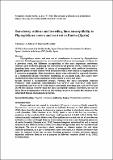Por favor, use este identificador para citar o enlazar a este item:
http://hdl.handle.net/10261/166562COMPARTIR / EXPORTAR:
 SHARE
BASE SHARE
BASE
|
|
| Visualizar otros formatos: MARC | Dublin Core | RDF | ORE | MODS | METS | DIDL | DATACITE | |

| Campo DC | Valor | Lengua/Idioma |
|---|---|---|
| dc.contributor.author | Borrero, C. | es_ES |
| dc.contributor.author | Refoyo, A. | es_ES |
| dc.contributor.author | Sanz, Carlos | es_ES |
| dc.date.accessioned | 2018-06-19T06:58:40Z | - |
| dc.date.available | 2018-06-19T06:58:40Z | - |
| dc.date.issued | 2017-04-20 | - |
| dc.identifier.citation | Acta Horticulturae 1156: 777-780 (2017) | es_ES |
| dc.identifier.issn | 0567-7572 | - |
| dc.identifier.uri | http://hdl.handle.net/10261/166562 | - |
| dc.description | 4 Páginas, 1 Figura | es_ES |
| dc.description.abstract | Phytophthora crown and root rot of strawberries is caused by Phytophthora cactorum. Breeding programs for resistance to this disease are in progress in Spain. In a previous work, the different susceptibility of the most important strawberry cultivars used in Huelva (Spain) was observed. In the present work, 2 cultivars and 3 breeding lines were included in assays of susceptibility with artificial inoculation. Eighteen plants of each cultivar were inoculated with a root bath in a suspension with P. cactorum propagules. After inoculation, plants were cultivated in a growth chamber in a randomized design with three repetitions of six plants each. The assays were conducted two times from September to December in 2014 and 2015. Results showed 4 susceptibility groups: 'Fortuna' the most susceptible cultivar; 'Primoris' with moderate susceptibility; 'A11-407P-3' and 'A10-48-3' with lower susceptibility and 'A10-207P-8' the lowest susceptible breeding line. 'A10-207P-8' had 56.4% less disease severity than the most susceptible cultivar. Therefore, the use of these three breeding lines will be an interesting resource to control this disease in an integrated disease management program. | es_ES |
| dc.description.sponsorship | This research was supported by grants from Corporación Tecnológica de Andalucía (CTA: 12/633). We thank S. Castillo, A. Gata and S. Pérez for excellent technical assistance. | es_ES |
| dc.language.iso | eng | es_ES |
| dc.publisher | International Society for Horticultural Science | es_ES |
| dc.relation.isversionof | Postprint | es_ES |
| dc.rights | openAccess | en_EN |
| dc.subject | Breeding | es_ES |
| dc.subject | Fragaria × ananassa | es_ES |
| dc.subject | Soilborne | es_ES |
| dc.subject | Disease | es_ES |
| dc.subject | Phytophthora cactorum | es_ES |
| dc.title | Strawberry cultivar and breeding lines susceptibility to Phytophthora crown and root rot in Huelva (Spain) | es_ES |
| dc.type | artículo | es_ES |
| dc.description.peerreviewed | Peer reviewed | es_ES |
| dc.relation.publisherversion | http://dx.doi.org/10.17660/ActaHortic.2017.1156.114 | es_ES |
| dc.embargo.terms | 2019-04-20 | es_ES |
| dc.contributor.funder | Corporación Tecnológica de Andalucía | es_ES |
| dc.relation.csic | Sí | es_ES |
| oprm.item.hasRevision | no ko 0 false | * |
| dc.identifier.funder | http://dx.doi.org/10.13039/501100006466 | es_ES |
| dc.type.coar | http://purl.org/coar/resource_type/c_6501 | es_ES |
| item.openairetype | artículo | - |
| item.grantfulltext | open | - |
| item.cerifentitytype | Publications | - |
| item.openairecristype | http://purl.org/coar/resource_type/c_18cf | - |
| item.fulltext | With Fulltext | - |
| item.languageiso639-1 | en | - |
| Aparece en las colecciones: | (IG) Artículos | |
Ficheros en este ítem:
| Fichero | Descripción | Tamaño | Formato | |
|---|---|---|---|---|
| Postprint_2017_ActaHortic_V1156_P777.pdf | Artículo principal | 545,1 kB | Adobe PDF |  Visualizar/Abrir |
CORE Recommender
Page view(s)
220
checked on 19-abr-2024
Download(s)
242
checked on 19-abr-2024
Google ScholarTM
Check
NOTA: Los ítems de Digital.CSIC están protegidos por copyright, con todos los derechos reservados, a menos que se indique lo contrario.
